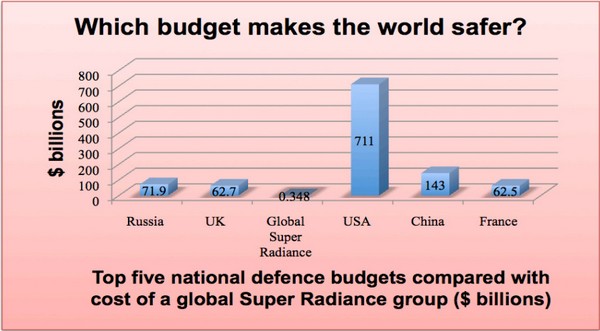This is a section (start on page 22) from a free PDF book that you can download from a website about the most powerful and cost effective way to create world peace:
http://www.worldpeacegroup.org/Super_Radiance_research_summaries.html
“The disproportionate impact that a Super Radiance group achieves as it grows larger means that the creation and maintenance of global Super Radiance is easily within the resources of any one of the developed nations both in terms of money and numbers of trained TM-Sidhas.
Take the annual defence budget of the worlds leading spenders on national defence, and compare it with the amount estimated to support and maintain a global Super Radiance group of 8,400 TM-Sidhas. As you can see from the chart, the contrast in costs is staggering. Yet repeated research shows that only the Super Radiance group can actually guarantee the safety of any of these nations. But in addition, a global group of TM-Sidhas is capable of securing the peace and safety of all the other nations as well.
With Super Radiance nobody loses, everybody wins. What is required, to achieve peace on earth once and for all, is for a sufficient number of people to be aware of this immense possibility and then take the personal responsibility to help make it happen.
And herein lies the immediate problem.
Why politicians, government officials, and the media do not take up this idea
After twenty-years of research, much of it published in peer reviewed academic journals and after thirty years of trying to get the message across about Super Radiance, governments, at least in the G20 nations, have resolutely refused to hear the message and respond constructively. The media have remained deaf to reason, as have the politicians, NGOs, think tanks and government officials.
Why is this? The answer to this puzzle lies in the realm of beliefs.
Pre-existing beliefs can be a huge obstacle to the adoption of radical new ideas. In fact beliefs can also block the learning of anything significant, prevent successful problem solving, and subvert effective planning and decision-making. The obstacle arises because whenever new evidence conflicts with our beliefs there is a particular facet of the brain that filters out this evidence from our conscious perception. In this sense, the brain is wired in a way so that we literally can’t see what we don’t already believe in. When this deception occurs, we make, what the psychologists term, a ‘premature cognitive commitment’. In other words we jump to a conclusion based, not on available new evidence, but on our pre-existing belief about the situation. In this context, I use the term ‘belief’ not in the religious sense but generically to include any pre-existing supposition, assumption, preconception, self-belief, ideology, hypothesis, theory, premise, attachments or the emotional memory of some past associated event or situation. All these sub-categories of belief are fully capable of getting in the way of you seeing the facts.
Cognitive dissonance and confirmation bias
As you can see, whenever we may be experiencing premature cognitive commitment our beliefs become seriously self-limiting. The brain seems programmed to use beliefs to help us make sense of customary situations quickly. But, sometimes this is at the expense of really learning what is going on. The obstruction to learning occurs because we are comfortable with our beliefs, whereas the process of changing them or being confronted with their inadequacy can be acutely uncomfortable to us. Typically our beliefs are very dear to us, and can even form part of our identity. So, new information that contradicts our existing beliefs essentially threatens our sense of meaning and even our sense of security, or of knowing who we are (or more accurately threatening our belief as to who we are). Like any other threat to our emotional needs these acutely intimate threats to both our sense of meaning and identity trigger a powerful stress response. In other words, at the point of conflict between our belief and the contradictory facts, we become emotionally aroused and slip quickly into our primeval flight or fight mode. This type of mental stress response is known as ‘cognitive dissonance’.
The relevance of cognitive dissonance to the assimilation of new information is important. In a situation where the apparent facts or evidence seem to contradict entrenched beliefs, cognitive dissonance compels us to do one of two things. At the moment we receive the conflicting information we feel compelled to remove the threat and reduce the pain of the dissonance. To achieve this immediate aim we do one of two things. Either we change our belief to match the revealed facts or we try and preserve our belief by conducting what has been termed ‘confirmation bias’ (sometimes known as ‘myside bias’). Typically where we have been caught unawares or where we are not accustomed to having our settled worldview challenged or where we have deep-rooted attachments to our beliefs, we tend to adopt the second approach. At the moment of arousal, we go for some sort of confirmation bias.
In effect when given the choice of either doing what is right or doing what is easy we tend to choose the easy option. What comes easy to people is a range of less than useful learning tactics. These can include a stubborn resistance to change; a wilful misinterpretation of the facts; the demonization of opposing views; the obsessive hunt for any possible evidence, however weak, to back-up our beliefs; a trancelike or oblivious denial of the situation, hysterical opposition to the alternative idea and solution; an evangelical crusade to persuade others to follow our beliefs; and the persistent advocacy of anachronistic and otherwise highly inappropriate solutions that tend to perpetuate the problems not ease them; all this as a ruse to escape the pain of adapting to new ideas and new evidence.
What is missing in the heat of this emotional reaction is the cool, calm and objective assimilation of the new ideas by our higher faculties. The stress response prevents a balanced evaluation of the facts and the development of rational judgement.
Cognitive dissonance
The three unwise monkeys of premature cognitive commitment, cognitive dissonance and confirmation bias are responsible for a lot of harm in society, especially in organisational and political life. This new understanding of the brain’s filtering system explains why bad news about an organisation is often met with disbelief by senior managers and why, they often find it difficult to accept negative feedback that disrupts their settled worldview of how they are running things. Instead of working with the new information to improve things they tend to chastise those who offer differing opinions or who expose the facts and brand them ‘whistle blowers’.
Similarly, this phenomenon accounts for the common experience of scientists, politicians and others dismissing or disregarding factual evidence when it does not meet the criteria laid down by their pre-existing beliefs, ideologies, theories and understanding.
Cognitive dissonance is the main obstacle to world peace
The significance of this phenomenon in the context of Super Radiance and world peace is therefore obvious. Most of us have been brought up with the ingrained view that the universe is a purely material phenomenon. Essentially the common belief, reinforced of course on a daily basis by our common senses, is that the universe exists within a linear time frame and is made up of pieces of matter separated by vast tracts of intergalactic space. In essence the common and habitual belief is that I am in here and everything else is out there. Our intellect takes the cue from our common senses and sees us as separate to the rest of the world. Whereas the fact is that the universe is a playground of self-interacting energy and intelligence and every one of us is an integral part of it. Unfortunately, those who still hang on to their old beliefs are literally physically blocked from recognising the actuality that the widespread view of the material universe is largely an illusion of the common senses.
Propositions that contradict the established worldview are deeply threatening to people’s sense of meaning, which explains the rigid resistance or simple denial to the idea of Super Radiance.
Psychology recognises that ‘meaning’, is an important motivational human need.
Those of us who have now got used to the idea about Super Radiance have to accept that the research around it violates an important sense of meaning for many people and this of course includes scientists, academics, journalists, politicians and officials in senior positions. Violating an emotional need can quickly trigger a powerful stress response. In other words the sort of cognitive dissonance provoked by this type of situation, where the evidence conflicts directly with both the subject’s belief and sense of meaning, is extremely uncomfortable. You can see that the experiencer is faced with evidence that seems to undermine the very purpose of their work, their careers, their belief in their own competence (a feeling of competence also being an emotional need) and perhaps even the fundamental validity of their organisation. As a result, the reptilian survival mechanism kicks in and it becomes far easier, quicker and simpler to ignore the evidence, carry on as usual and try and persuade everybody that everything is OK the way things are. This is by way of an explanation not an excuse.
Our supreme challenge is not so much trying to create world peace but getting enough people to believe that we can.
This premature cognitive commitment to this essentially materialistic view of existence is predominantly the reason why the impressive research on Super
Radiance has been largely ignored by governments, international agencies such as the UN, and also the media. Such people literally cannot see the evidence placed before them. As a consequence, Super Radiance is mostly unheard of among the wider public.
When we can recognise the deeper reality that all the diverse strands of life in the universe coexist in a universal field of lively consciousness, then the apparent magical effect of people sitting in a room in silence with their eyes shut and having a direct impact on millions of others thousands of miles away across the globe suddenly becomes a plausible possibility.
Part of the aim of this book is to help more people break through the fallacy of their common senses and social conditioning and so become aware of what our generation can achieve if only we are alert enough to grasp the responsibility. Read the research summaries for yourself and you will see that the facts are unequivocal; the evidence is beyond doubt. We now have a practical and reliable technology to release our societies from the grip of warfare, terrorism, violence and crime.
Whether we take advantage of this opportunity or not is entirely up to us.”




“All truth passes through three stages. First, it is ridiculed. Second, it is violently opposed. Third, it is accepted as being self-evident.”
–Arthur Schopenhauer, German philosopher (1788 – 1860)